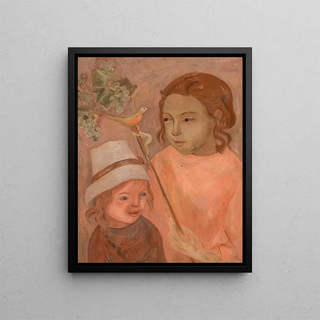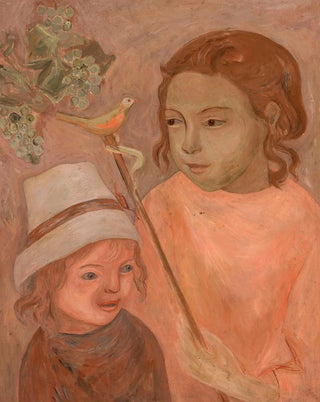Art print | Children with a bird on the tree - Tadeusz Makowski


View from behind

Frame (optional)
Captivating Introduction
In the rich and complex universe of art, some works manage to capture childhood innocence and magic with such intensity that they transcend time. "Children with a Bird on the Tree" by Tadeusz Makowski is one of these creations. This piece, imbued with poetry and delicacy, evokes a world where imagination blends with everyday life, where children, symbols of purity, interact with nature in an almost mystical way. The art print of this work allows us to bring this enchanting atmosphere into our living spaces, offering a visual and emotional escape for those who contemplate it.
Style and uniqueness of the work
Tadeusz Makowski's style is distinguished by a unique approach that combines a palette of soft colors with stylized forms. In "Children with a Bird on the Tree," the children's figures are depicted with a simplicity that does not diminish the depth of their emotions. The faces, with delicate features, express both curiosity and wonder, while the tree, majestic and protective, seems to witness this innocent interaction. The composition, balanced and harmonious, guides the viewer's eye through the work, creating a dialogue between the characters and their environment. The light, omnipresent, bathes the scene in an almost dreamlike softness, making this art print not only a reflection of childhood but also a celebration of natural beauty.
The artist and his influence
Tadeusz Makowski, Polish artist of the early 20th century, made a name for himself in the art world thanks to his keen sense of observation and his ability to translate human emotions through scenes of everyday life. Influenced by the artistic movements of his time, Makowski developed a style that is uniquely his own, blending realism and abstraction. His work is often marked by a particular sensitivity towards children, whom he considers as beings both fragile and powerful. By incorporating elements of Polish culture and French influences, he created a visual language that resonates with

Matte finish

View from behind

Frame (optional)
Captivating Introduction
In the rich and complex universe of art, some works manage to capture childhood innocence and magic with such intensity that they transcend time. "Children with a Bird on the Tree" by Tadeusz Makowski is one of these creations. This piece, imbued with poetry and delicacy, evokes a world where imagination blends with everyday life, where children, symbols of purity, interact with nature in an almost mystical way. The art print of this work allows us to bring this enchanting atmosphere into our living spaces, offering a visual and emotional escape for those who contemplate it.
Style and uniqueness of the work
Tadeusz Makowski's style is distinguished by a unique approach that combines a palette of soft colors with stylized forms. In "Children with a Bird on the Tree," the children's figures are depicted with a simplicity that does not diminish the depth of their emotions. The faces, with delicate features, express both curiosity and wonder, while the tree, majestic and protective, seems to witness this innocent interaction. The composition, balanced and harmonious, guides the viewer's eye through the work, creating a dialogue between the characters and their environment. The light, omnipresent, bathes the scene in an almost dreamlike softness, making this art print not only a reflection of childhood but also a celebration of natural beauty.
The artist and his influence
Tadeusz Makowski, Polish artist of the early 20th century, made a name for himself in the art world thanks to his keen sense of observation and his ability to translate human emotions through scenes of everyday life. Influenced by the artistic movements of his time, Makowski developed a style that is uniquely his own, blending realism and abstraction. His work is often marked by a particular sensitivity towards children, whom he considers as beings both fragile and powerful. By incorporating elements of Polish culture and French influences, he created a visual language that resonates with






